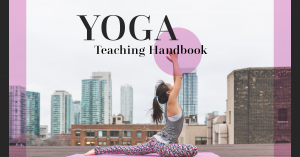In Yoga Teaching Handbook, a new release for November, you can read expert advice on teaching yoga and managing a successful yoga business. One of the contributors of the book, Alison Purchase, has put together ten top tips for new yoga teachers, which you can read below.
1: Keep your class plan flexible.
Plan the general structure of a class rather than each pose. That way you can adapt the class based on the students’ needs and you won’t feel stressed if you forget what pose you had planned next.
2: Take an interest in your students.
If you arrive early and stay late, you have the opportunity to chat with your students and find out more about them. Students often have questions or are looking for advice to develop their practice.
3: Be creative.
Unless you teach Ashtanga, don’t do the same sequence of poses every week. I like to be creative with Sun Salutations and while I have a particular style and structure to my class, I do different poses every week to keep things fresh.
4: Keep to time.
Running over in a class sends the message that your time is more important than the students’.
5: Give modifications.
All your students will be at different levels and places in their lives. There is no point in pushing someone to do something they aren’t ready to do. Providing modifications that are easier and more challenging than the base pose means students can go at their own pace. This is especially important in drop-in or general classes where you’ll get a wide range of students with different needs and abilities.
6: Stay calm.
Students expect a relaxed and confident teacher, so keep your composure even if you’ve had a terrible day or you draw a blank. If you need time to think about what pose to go to next, put the class into Down Dog or Child Pose while you think about it.
7: Try not to get overly concerned with students’ facial expressions.
When people concentrate, they can look bored, confused or even angry. Chat to your students after the class to find out how they got on.
8: Don’t overdo the number of classes you commit to.
Be realistic on what you can balance with your personal life and any other work you’re doing, especially if you work full-time. When you teach you’re sharing your energy; taking on too many classes can cause burnout. If you’re feeling stressed or overwhelmed, this will come across in your teaching.
9: Don’t speak for the sake of speaking.
You don’t need to speak the entire time; choose your words mindfully and give your class the space to reflect on their practice and their breathing by allowing some quiet pauses throughout your class.
10: Maintain the energy of the room.
As the teacher, you hold the energy of a room. Be the first person to open the door at the end of the class to release the energy and never leave the class during the relaxation.
Yoga Teaching Handbook is an essential resource for yoga teachers and yoga trainees which offers help and guidance on the day-to-day practicalities of teaching and running a yoga business. The book includes insights from renowned yoga professionals, including Liz Lark, Lizzie Lasater, Andrew McGonigle, Katy Appleton and Tarik Dervish and more. You can read more about Yoga Teaching Handbook here.
If you would like to read more articles like this and hear the latest news and offers on our books, why not join our mailing list? We can send information by email or post as you prefer, and please also tell us about your areas of interest so we can send the most relevant information. You can unsubscribe at any time.
